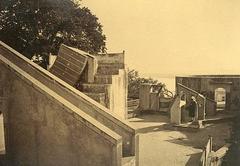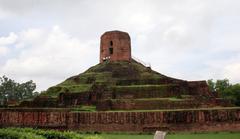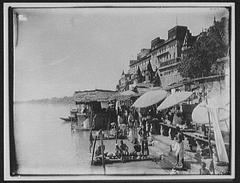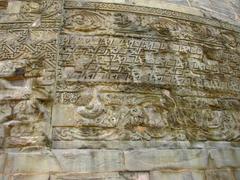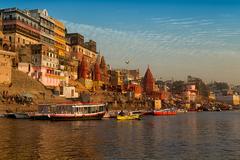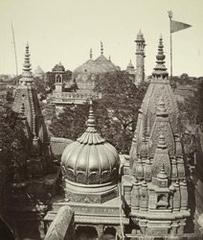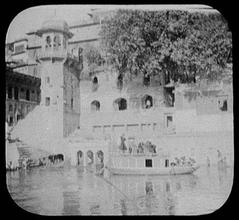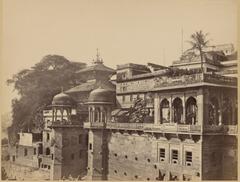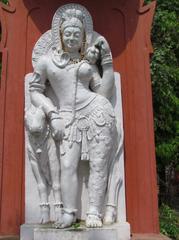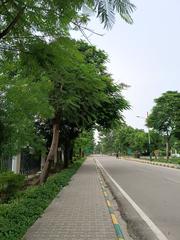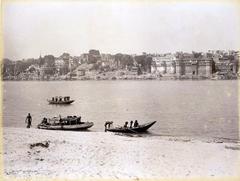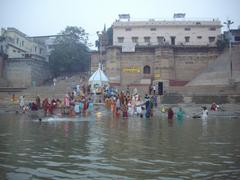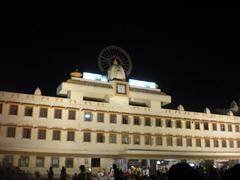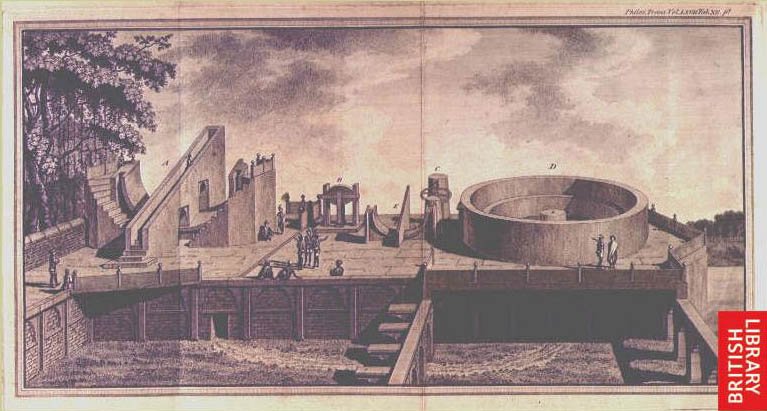
Visiting Hours and Tickets for Manmandir Ghat, Varanasi: A Comprehensive Guide
Publication Date: 23/07/2024
Introduction to Manmandir Ghat
Manmandir Ghat, located on the western bank of the Ganges River in Varanasi, India, is a site steeped in rich history and cultural significance. Constructed in 1585 by Maharaja Man Singh of Amber, this ghat is a testament to the grandeur of Rajput architecture, featuring intricate stone carvings and ornate balconies (Varanasi.org). The ghat is not only an architectural marvel but also a spiritual hub, attracting pilgrims who perform various religious rituals, including the sacred Ganga Aarti, and cultural enthusiasts who gather to witness music and dance performances (Times of India). A significant feature of Manmandir Ghat is the Jantar Mantar observatory, built by Maharaja Jai Singh II, which houses ancient astronomical instruments used for celestial calculations (Cultural India). This comprehensive guide aims to provide visitors with an in-depth understanding of the ghat’s historical background, architectural significance, religious importance, and practical information for planning a visit.
Table of Contents
- [Introduction](#introductionintroduction-to-manmandir-ghat)
- [Historical Background](#historical-backgroundhistorical-background)
- [Architectural Significance](#architectural-significancearchitectural-significance)
- [Religious Importance](#religious-importancereligious-importance)
- [Cultural Significance](#cultural-significancecultural-significance)
- [Astronomical Observatory - Jantar Mantar](#astronomical-observatory---jantar-mantarastronomical-observatory---jantar-mantar)
- [Visitor Information](#visitor-informationvisitor-information)
- [Visiting Hours and Tickets](#visiting-hours-and-ticketsvisiting-hours-and-tickets)
- [Travel Tips](#travel-tipstravel-tips)
- [Nearby Attractions](#nearby-attractionsnearby-attractions)
- [Preservation and Conservation Efforts](#preservation-and-conservation-effortspreservation-and-conservation-efforts)
- [Modern-Day Relevance](#modern-day-relevancemodern-day-relevance)
- [Frequently Asked Questions (FAQ)](#frequently-asked-questions-faqfrequently-asked-questions-faq)
- [Conclusion](#conclusionconclusion)
- [Call to Action](#call-to-actioncall-to-action)
- [Sources and Further Reading](#sources-and-further-readingsources-and-further-reading)
Historical Background
Manmandir Ghat, constructed in 1585 by Maharaja Man Singh of Amber, is one of the oldest and most historically significant ghats in Varanasi. The ghat reflects the grandeur of Rajputana architecture, characterized by its intricate stone carvings and ornate balconies (Varanasi.org).
Architectural Significance
The Manmandir Ghat features the Manmandir Palace, showcasing exquisite Rajput architecture. The palace is adorned with beautifully carved stone windows, known as jharokhas, and balconies that offer a panoramic view of the Ganges. The palace also houses the Jantar Mantar observatory, built by Maharaja Jai Singh II, which includes various instruments used for measuring time, predicting eclipses, and tracking celestial bodies (Cultural India).
Religious Importance
Manmandir Ghat holds immense religious significance for Hindus. Varanasi, also known as Kashi, is considered one of the holiest cities in Hinduism, and the ghats along the Ganges are central to the city’s spiritual life. Pilgrims visit Manmandir Ghat to perform various religious rituals, including the sacred Ganga Aarti, a daily evening ritual dedicated to the River Ganges. The ghat is also a popular site for performing pind daan, a ritual for the salvation of ancestors’ souls (Times of India).
Cultural Significance
The cultural significance of Manmandir Ghat extends beyond its religious importance. The ghat has been a center for cultural activities, including music, dance, and literature. It has been a source of inspiration for poets, writers, and artists who have captured its beauty and spiritual essence in their works. The ghat’s serene environment and historical backdrop make it a popular spot for cultural events and festivals, attracting both locals and tourists (Incredible India).
Astronomical Observatory - Jantar Mantar
One of the most notable features of Manmandir Ghat is the Jantar Mantar observatory. Built by Maharaja Jai Singh II, the observatory is one of the five astronomical observatories constructed by the king in India. The instruments at Jantar Mantar, including the Samrat Yantra, the Jai Prakash Yantra, and the Ram Yantra, were used for various astronomical calculations. These instruments reflect the advanced scientific knowledge and astronomical expertise of the period. The observatory is a testament to the scientific and architectural achievements of ancient India (ASI India).
Visitor Information
Visiting Hours and Tickets
Manmandir Ghat is accessible to visitors 24 hours a day, but the ideal time to visit is during the early morning hours or in the evening for the Ganga Aarti ceremony. There is no entry fee for visiting the ghat itself, but if you wish to explore the Manmandir Palace and Jantar Mantar observatory, there might be a nominal entry fee. It is advisable to check the latest information from local sources or official websites before planning your visit.
Travel Tips
- Best Time to Visit: The best time to visit Varanasi is during the cooler months from October to March. This period offers a pleasant climate for exploring the ghats and participating in religious ceremonies.
- Guided Tours: For a more informative experience, consider hiring a local guide who can provide insights into the history and significance of Manmandir Ghat and other nearby attractions.
- Safety: While the ghats are generally safe, it’s important to be cautious of your belongings and avoid isolated areas after dark.
Nearby Attractions
- Dashashwamedh Ghat: One of the most famous ghats in Varanasi, known for its lively atmosphere and the grand Ganga Aarti ceremony.
- Kashi Vishwanath Temple: A major pilgrimage site dedicated to Lord Shiva, located close to Manmandir Ghat.
- Ramnagar Fort: Situated on the eastern bank of the Ganges, this fort offers an intriguing glimpse into the regal past of Varanasi.
Preservation and Conservation Efforts
Over the years, efforts have been made to preserve and restore the historical and architectural heritage of Manmandir Ghat. The Archaeological Survey of India (ASI) has undertaken several conservation projects to maintain the structural integrity of the ghat and its associated buildings. These efforts include the restoration of the stone carvings, the reinforcement of the palace structure, and the preservation of the astronomical instruments at Jantar Mantar. The conservation initiatives aim to protect the ghat’s historical and cultural legacy for future generations (ASI India).
Modern-Day Relevance
Today, Manmandir Ghat continues to be a significant landmark in Varanasi. It attracts thousands of visitors annually, including pilgrims, tourists, historians, and researchers. The ghat’s historical and cultural heritage, combined with its religious significance, makes it a must-visit destination for anyone exploring Varanasi. The ghat also plays a crucial role in the city’s tourism industry, contributing to the local economy and promoting cultural exchange (Varanasi Tourism).
Frequently Asked Questions (FAQ)
What are the visiting hours for Manmandir Ghat?
Manmandir Ghat is open 24 hours a day, but the best times to visit are early morning or evening.
How much do tickets to Manmandir Ghat cost?
There is no entry fee for the ghat itself. However, there might be a nominal fee for the Manmandir Palace and Jantar Mantar observatory.
What are the nearby attractions to Manmandir Ghat?
Nearby attractions include Dashashwamedh Ghat, Kashi Vishwanath Temple, and Ramnagar Fort.
Conclusion
Manmandir Ghat stands as a symbol of Varanasi’s rich historical, cultural, and religious heritage. Its architectural splendor, religious importance, and cultural significance make it a unique and invaluable part of the city’s landscape. The ongoing preservation efforts ensure that this historical gem continues to inspire and attract visitors from around the world, offering them a glimpse into the glorious past of one of India’s oldest cities.
Call to Action
Plan your visit to Manmandir Ghat and explore the rich heritage of Varanasi. For more information on Varanasi’s historical sites or to book guided tours, visit our website or download our mobile app Audiala. Follow us on social media for the latest updates and travel tips.
Sources and Further Reading
- Varanasi.org (n.d.). Man Mandir Ghat. Varanasi.org
- Cultural India (n.d.). Jantar Mantar. Cultural India
- Times of India (n.d.). Man Mandir Ghat. Times of India
- ASI India (n.d.). Jantar Mantar, Varanasi. ASI India
- Incredible India (n.d.). Varanasi. Incredible India
- Varanasi Tourism (n.d.). Varanasi. Varanasi Tourism

